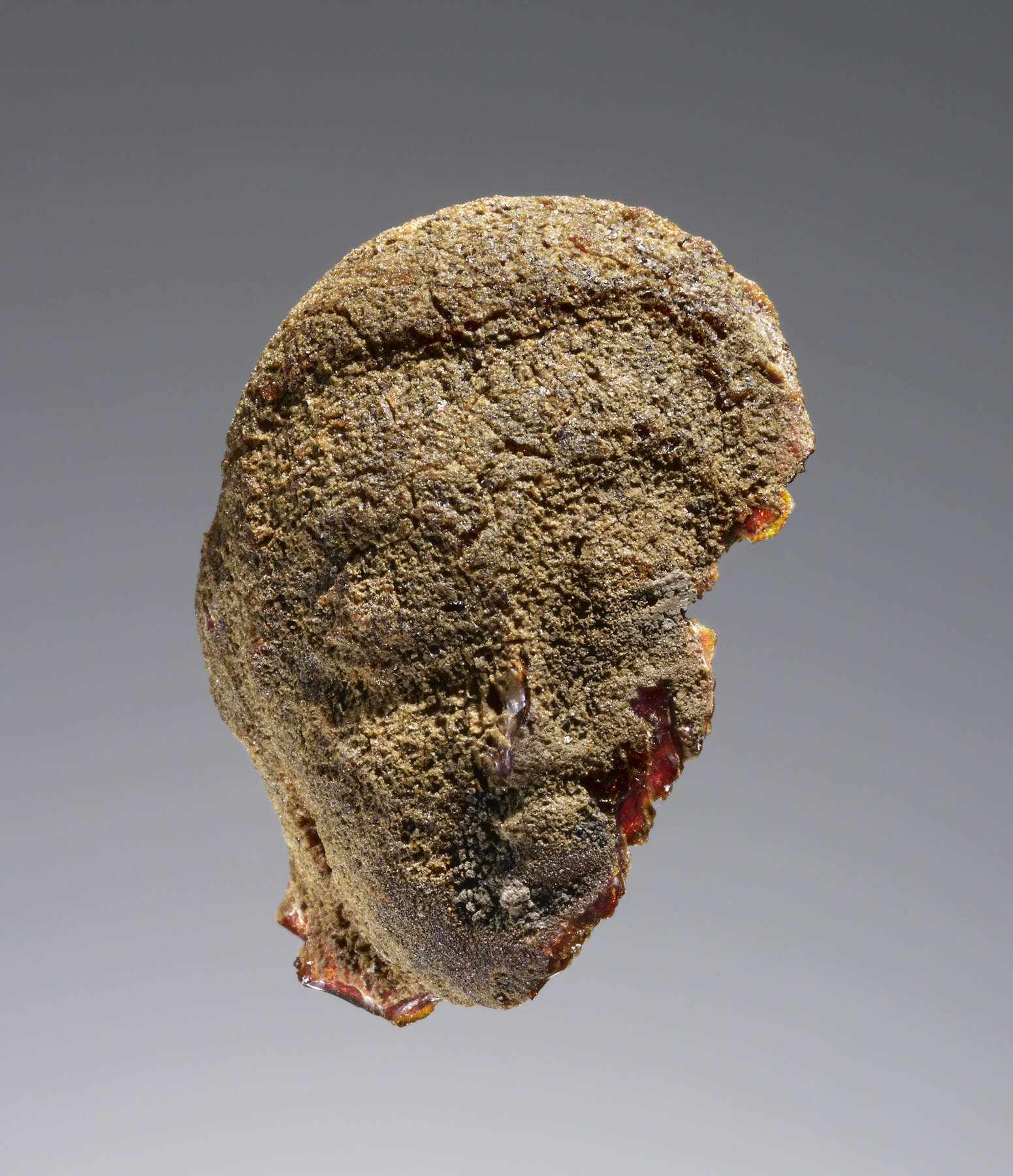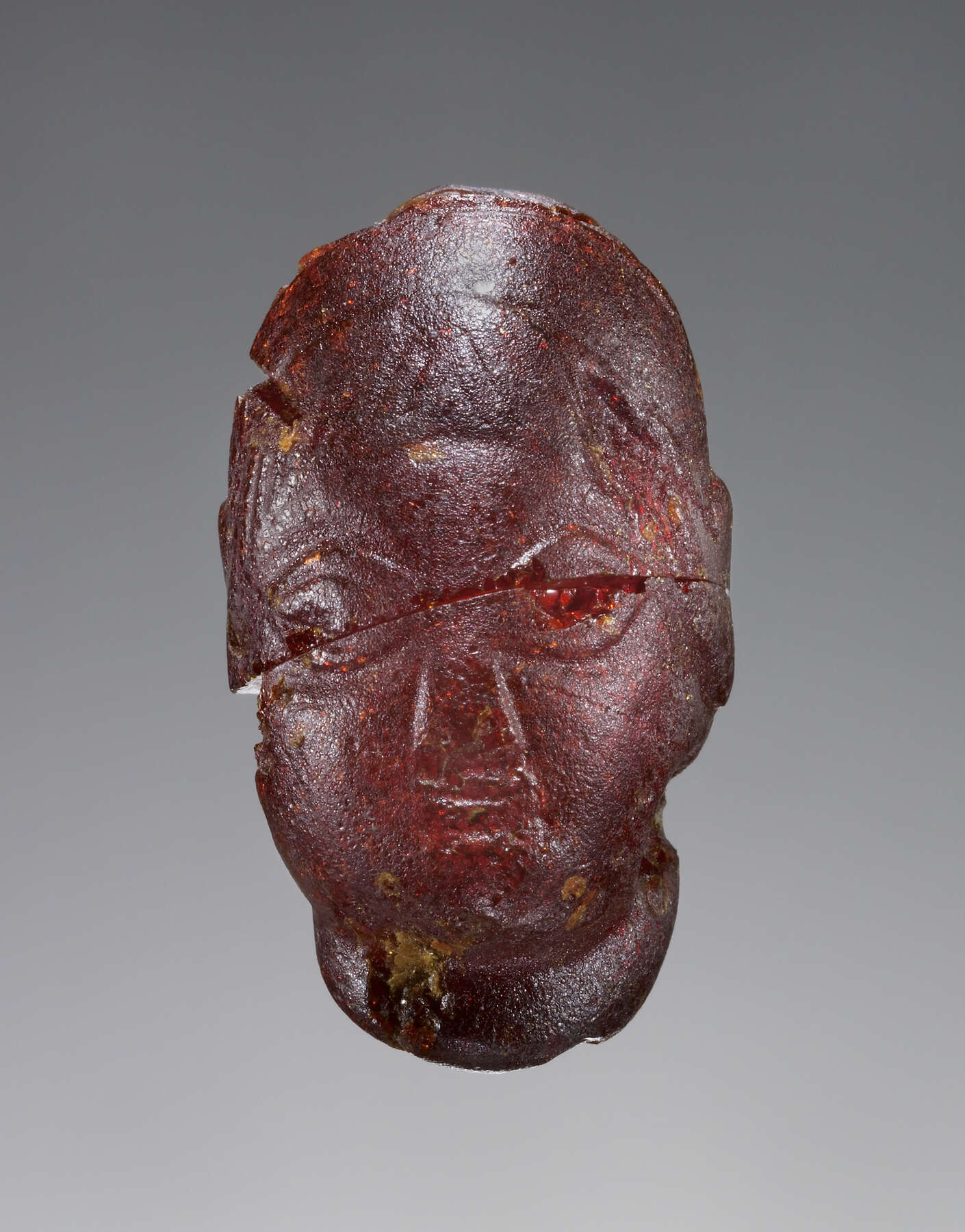9. Pendant: Head Fragment from a Standing Female Figure (Kore)
| Accession Number | 82.AO.161.6 |
| Culture | Etruscan |
| Date | 525–500 B.C. |
| Dimensions | Height: 31 mm; width: 20 mm; depth: 18 mm; Weight: 2 g |
| Subjects | Ionia, Greece (also Ionian, Greek) |
Provenance
–1982, Jiří Frel, 1923–2006, and Faya Frel (Los Angeles, CA), donated to the J. Paul Getty Museum, 1982.
Condition
The amber is fragmentary: a large section of the left side of the head and the neck and a portion of the back of the pendant were broken off at some remote time, as is suggested by the weathering. Overall, the surface is worn and grainy but not friable. The surface is covered by a yellow-orange crust that obscures the underlying red-orange amber. There are new chips in several areas, especially along the edges, that have exposed glassy amber below. In natural light, the piece is opaque and yellowish brown. At the new breaks, which expose the interior, it is red-orange. It is not translucent under artificial light, and it is impossible to see if there are any inclusions. There is a stopped bore on the back of the head, and just below the right ear is a stopped bore with a plug of amber still inside it.
Description
This is a fragmentary and weathered object. What remains is the head and neck of a female figure. The brow is short, and the cheeks are modeled and full. The large, almond-shaped eyes have narrow rims. The nose is eroded, but its general form is still evident: it is triangular, short, and relatively narrow through the nares. The mouth is wider than the nose. The jaw area is wide. The hair at the brow is dressed in a wave pattern. In front of the right ear is a large coil of hair. The rest of the figure’s hair is covered with a veil.
There is no surviving suspension device. However, the groove at the break on the left side of the head and the groove and break on the underside of the neck are likely two sides of a triangular suspension system.
Discussion
82.AO.161.6 was donated along with a large and varied group of amber beads and pendants about which little is known.
This fragment is unlike any other figured carved amber. Because of the odd break at the bottom of the piece and the remains of a triangular perforation system, it is proposed here that 82.AO.161.6 is the upper part of a standing figure and not a head-pendant. The three holes would have allowed the sculpture to hang upright. A number of other figured ambers from Italy, or said to be from Italy, and dating to between the seventh and fifth centuries were perforated for stringing in a similar manner.1 The best parallel is another fragmentary amber pendant, in a London private collection, which represents a seated woman and child. It dates to the mid-seventh century B.C. and was probably carved at Vetulonia.
The figure of 82.AO.161.6 is similar in physiognomic type and dress to a group of sixth-century B.C. marbles from Ionia, from the area of Samos, Miletos, and Didyma. The telling comparisons are (1) a small marble head of a kore from Miletos(?) in Paris; (2) the statue of Dionysermos in the Louvre (from Samos? Miletos?); (3) two votive reliefs of standing women in aediculae from Miletos in Berlin; and (4) the fragmentary figures from the column bases found near the temple of Apollo at Didyma, also in Berlin.2
The amber, like the marbles, has a wide face with full, round cheeks, high cheekbones, slightly sunken areas at the lower edge of the eyes, and almond-shaped eyes. Those of the amber appear to be larger, but the shape and tilt are the same. The position of the veil on 82.AO.161.6, behind the brow-framing waves, is the same as that of the Louvre kore and the Berlin column base heads. The amber and the Didyma marbles have in common another detail of hairdressing, the thick curl of hair in front of the ears. The latter firmly places 82.AO.161.6 in the same sculptural tradition as that of the Louvre and Berlin marbles and aids in establishing a terminus post quem. The long veil of 82.AO.161.6 is also characteristic of South Ionian kore figures, as described in the previous catalogue entry. This is the same long veil intimated by the presentations of the Getty amber pendant of a female head, (cat. no. 26).
Notes
- (cat. no. 52) is a significant example of a pendant with multiple perforations. ↩
- For the Milesian kore head (Louvre Ma 4546), see , p. 57, no. 49; for the statue of Dionysermos (Louvre Ma 3600 [MND 2283]), ibid., pp. 59–60, no. 51; for the two Milesian votive reliefs in Berlin (Staatliche Museen 1792 and 1647), , p. 51, nos. 70–71, figs. 228–29; and , pl. 42; for the column base figures in Berlin (Staatliche Museen F724–25), , p. 60, nos. 96–97, figs. 296–300. ↩
Bibliography
- Hamiaux 1992
- Hamiaux, M. Les Sculptures grecques: Musée du Louvre. Vol. 1. Paris, 1992.
- Karakasi 2003
- Karakasi, K. Archaic Korai. Los Angeles, 2003.
- Richter 1968
- Richter, G. M. A. Korai. London, 1968.


